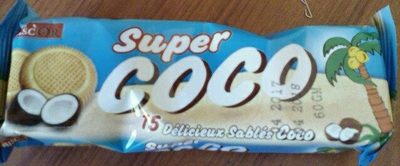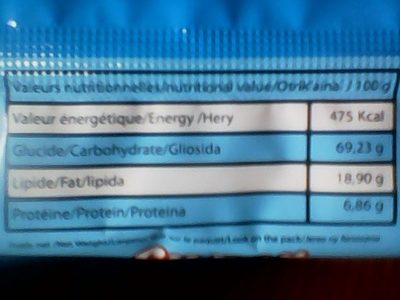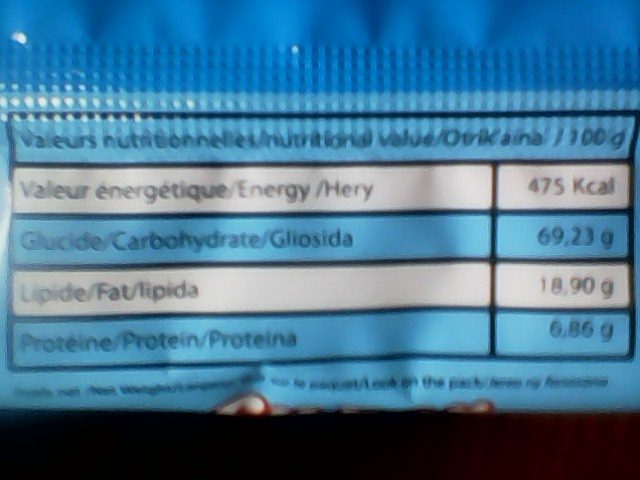Help us make food transparency the norm!
As a non-profit organization, we depend on your donations to continue informing consumers around the world about what they eat.
The food revolution starts with you!
SUPER COCO - BISC'OR - 60 g
SUPER COCO - BISC'OR - 60 g
This product page is not complete. You can help to complete it by editing it and adding more data from the photos we have, or by taking more photos using the app for Android or iPhone/iPad. Thank you!
×
Barcode: 6161105491507 (EAN / EAN-13)
Common name: BISCUIT AU COCO
Quantity: 60 g
Packaging: Plastic
Brands: BISC'OR
Categories: Snacks, Sweet snacks, Biscuits and cakes, Biscuits, Dry biscuits, Shortbread cookies, Sablés à la noix de coco
Origin of ingredients: Madagascar
Manufacturing or processing places: MADAGASCAR
Stores: SHOPRITE
Countries where sold: Madagascar
Matching with your preferences
Health
Ingredients
-
12 ingredients
: Farine de blé, sucre, matière graisse végétale, lait en poudre, poudre de noix de coco desséchées, poudre à lever (bicarbonate d'amonium E503_bicarbonate de sodium E500), metabisulfite de sodium E223, sel, lécithine de soja (E322), préparation aromatique.Allergens: Gluten, SoybeansTraces: Gluten
Food processing
-
Ultra processed foods
Elements that indicate the product is in the 4 - Ultra processed food and drink products group:
- Additive: E322 - Lecithins
- Ingredient: Flavouring
Food products are classified into 4 groups according to their degree of processing:
- Unprocessed or minimally processed foods
- Processed culinary ingredients
- Processed foods
- Ultra processed foods
The determination of the group is based on the category of the product and on the ingredients it contains.
Additives
-
E223 - Sodium metabisulphite
Sodium metabisulfite: Sodium metabisulfite or sodium pyrosulfite -IUPAC spelling; Br. E. sodium metabisulphite or sodium pyrosulphite- is an inorganic compound of chemical formula Na2S2O5. The substance is sometimes referred to as disodium metabisulfite. It is used as a disinfectant, antioxidant, and preservative agent.Source: Wikipedia
-
E322 - Lecithins
Lecithins are natural compounds commonly used in the food industry as emulsifiers and stabilizers.
Extracted from sources like soybeans and eggs, lecithins consist of phospholipids that enhance the mixing of oil and water, ensuring smooth textures in various products like chocolates, dressings, and baked goods.
They do not present any known health risks.
-
E322i - Lecithin
Lecithins are natural compounds commonly used in the food industry as emulsifiers and stabilizers.
Extracted from sources like soybeans and eggs, lecithins consist of phospholipids that enhance the mixing of oil and water, ensuring smooth textures in various products like chocolates, dressings, and baked goods.
They do not present any known health risks.
Ingredients analysis
-
May contain palm oil
Ingredients that may contain palm oil: Vegetable fat
-
Non-vegan
Non-vegan ingredients: Milk powderSome ingredients could not be recognized.
We need your help!
You can help us recognize more ingredients and better analyze the list of ingredients for this product and others:
- Edit this product page to correct spelling mistakes in the ingredients list, and/or to remove ingredients in other languages and sentences that are not related to the ingredients.
- Add new entries, synonyms or translations to our multilingual lists of ingredients, ingredient processing methods, and labels.
If you would like to help, join the #ingredients channel on our Slack discussion space and/or learn about ingredients analysis on our wiki. Thank you!
-
Vegetarian status unknown
Unrecognized ingredients: fr:bicarbonate-d-amonium-e503-bicarbonate-de-sodium-e500Some ingredients could not be recognized.
We need your help!
You can help us recognize more ingredients and better analyze the list of ingredients for this product and others:
- Edit this product page to correct spelling mistakes in the ingredients list, and/or to remove ingredients in other languages and sentences that are not related to the ingredients.
- Add new entries, synonyms or translations to our multilingual lists of ingredients, ingredient processing methods, and labels.
If you would like to help, join the #ingredients channel on our Slack discussion space and/or learn about ingredients analysis on our wiki. Thank you!
-
Details of the analysis of the ingredients
We need your help!
Some ingredients could not be recognized.
We need your help!
You can help us recognize more ingredients and better analyze the list of ingredients for this product and others:
- Edit this product page to correct spelling mistakes in the ingredients list, and/or to remove ingredients in other languages and sentences that are not related to the ingredients.
- Add new entries, synonyms or translations to our multilingual lists of ingredients, ingredient processing methods, and labels.
If you would like to help, join the #ingredients channel on our Slack discussion space and/or learn about ingredients analysis on our wiki. Thank you!
: Farine de blé, sucre, matière graisse végétale, lait en poudre, noix de coco desséchées, poudre à lever (bicarbonate d'amonium E503_bicarbonate de sodium e500), metabisulfite de sodium e223, sel, lécithine de soja (e322), préparation aromatique- Farine de blé -> en:wheat-flour - vegan: yes - vegetarian: yes - ciqual_proxy_food_code: 9410 - percent_min: 10 - percent_max: 100
- sucre -> en:sugar - vegan: yes - vegetarian: yes - ciqual_proxy_food_code: 31016 - percent_min: 0 - percent_max: 50
- matière graisse végétale -> en:vegetable-fat - vegan: yes - vegetarian: yes - from_palm_oil: maybe - percent_min: 0 - percent_max: 33.3333333333333
- lait en poudre -> en:milk-powder - vegan: no - vegetarian: yes - ciqual_proxy_food_code: 19044 - percent_min: 0 - percent_max: 25
- noix de coco desséchées -> en:desiccated-coconut - vegan: yes - vegetarian: yes - ciqual_food_code: 15007 - percent_min: 0 - percent_max: 20
- poudre à lever -> en:raising-agent - percent_min: 0 - percent_max: 16.6666666666667
- bicarbonate d'amonium E503_bicarbonate de sodium e500 -> fr:bicarbonate-d-amonium-e503-bicarbonate-de-sodium-e500 - percent_min: 0 - percent_max: 16.6666666666667
- metabisulfite de sodium e223 -> en:e223 - vegan: yes - vegetarian: yes - percent_min: 0 - percent_max: 14.2857142857143
- sel -> en:salt - vegan: yes - vegetarian: yes - ciqual_food_code: 11058 - percent_min: 0 - percent_max: 12.5
- lécithine de soja -> en:soya-lecithin - vegan: yes - vegetarian: yes - ciqual_food_code: 42200 - percent_min: 0 - percent_max: 11.1111111111111
- e322 -> en:e322 - vegan: maybe - vegetarian: maybe - percent_min: 0 - percent_max: 11.1111111111111
- préparation aromatique -> en:flavouring-preparation - vegan: maybe - vegetarian: maybe - percent_min: 0 - percent_max: 5
Nutrition
-
Missing data to compute the Nutri-Score
Missing nutrition facts
⚠ ️The nutrition facts of the product must be specified in order to compute the Nutri-Score.Could you add the information needed to compute the Nutri-Score? Add nutrition facts
-
Nutrient levels
-
Fat in moderate quantity (18.9%)
What you need to know- A high consumption of fat, especially saturated fats, can raise cholesterol, which increases the risk of heart diseases.
Recommendation: Limit the consumption of fat and saturated fat- Choose products with lower fat and saturated fat content.
-
-
Nutrition facts
Nutrition facts As sold
for 100 g / 100 mlAs sold
per serving (60 g)Compared to: Sables-a-la-noix-de-coco Energy 475 kj
(114 kcal)285 kj
(68 kcal)-77% Fat 18.9 g 11.3 g -27% Saturated fat ? ? Carbohydrates 69.23 g 41.5 g +16% Sugars ? ? Fiber ? ? Proteins 6.86 g 4.12 g +9% Salt ? ? Fruits‚ vegetables‚ nuts and rapeseed‚ walnut and olive oils (estimate from ingredients list analysis) 0 % 0 %
Environment
-
Eco-Score C - Moderate environmental impact
⚠ ️Select a country in order to include the full impact of transportation.The Eco-Score is an experimental score that summarizes the environmental impacts of food products.→ The Eco-Score was initially developped for France and it is being extended to other European countries. The Eco-Score formula is subject to change as it is regularly improved to make it more precise and better suited to each country.Life cycle analysis
-
Average impact of products of the same category: B (Score: 69/100)
Category: Shortbread pastry biscuit
Category: Shortbread pastry biscuit
- PEF environmental score: 0.35 (the lower the score, the lower the impact)
- including impact on climate change: 3.01 kg CO2 eq/kg of product
Stage Impact Agriculture
80.1 %Processing
12.2 %Packaging
3.1 %Transportation
3.2 %Distribution
1.4 %Consumption
0.0 %
Bonuses and maluses
-
Origins of ingredients with a high impact
Malus: -5
Environmental policy: -5
Transportation: 0
Origin of the product and/or its ingredients % of ingredients Impact Madagascar 100 %High
-
Packaging with a medium impact
Malus: -10
Shape Material Recycling Impact Unknown Plastic High ⚠ ️ The information about the packaging of this product is not sufficiently precise (exact shapes and materials of all components of the packaging).⚠ ️ For a more precise calculation of the Eco-Score, you can modify the product page and add them.
If you are the manufacturer of this product, you can send us the information with our free platform for producers.
Eco-Score for this product
-
Impact for this product: C (Score: 54/100)
Product: SUPER COCO - BISC'OR - 60 g
Life cycle analysis score: 69
Sum of bonuses and maluses: -15
Final score: 54/100
-
Carbon footprint
-
Equal to driving 1.6 km in a petrol car
301 g CO² per 100g of product
The carbon emission figure comes from ADEME's Agribalyse database, for the category: Shortbread pastry biscuit (Source: ADEME Agribalyse Database)
Stage Impact Agriculture
83.4 %Processing
7.8 %Packaging
3.7 %Transportation
4.5 %Distribution
0.6 %Consumption
0.0 %
Packaging
-
Packaging with a medium impact
-
Packaging parts
(Plastic)
-
Packaging materials
Material % Packaging weight Packaging weight per 100 g of product Plastic
-
Transportation
-
Origins of ingredients
Origins of ingredients with a high impact
Origin of the product and/or its ingredients % of ingredients Impact Madagascar 100 %High
Report a problem
-
Incomplete or incorrect information?
Category, labels, ingredients, allergens, nutritional information, photos etc.
If the information does not match the information on the packaging, please complete or correct it. Open Food Facts is a collaborative database, and every contribution is useful for all.
Data sources
Product added on by fabienne411
Last edit of product page on by packbot.
Product page also edited by teolemon.







